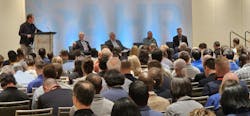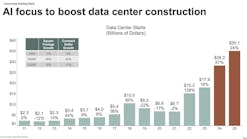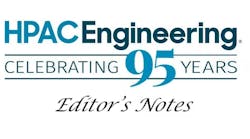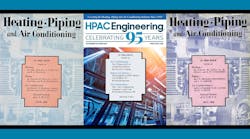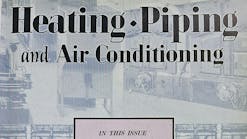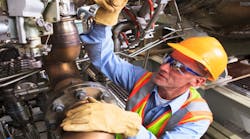The Covid-19 pandemic put public health in the lime light. In the fall of 2019, few Americans had heard of the National Institute of Allergy and Infectious Diseases or its director, Dr. Anthony Fauci, M.D. By April 2020, few Americans had NOT heard of Dr. Fauci, who appeared regularly on TV and radio and was widely quoted in the press for his advice on all things related to the pandemic. From eviction moratoria1 to face mask mandates2, public health was literally in your face, 24/7.
And, of course, the focus on public health extended to the HVAC industry, as well.
From February through July of this year, each issue of ASHRAE Journal included a feature article related to airborne infection. In their zeal to keep the focus on public health, 39 prominent co-authors wrote an article for Science3 that proposes indoor air quality should be a leading tool in fighting respiratory infection. Not one of the authors is a practicing engineer, putting the article in the realm of making promises for someone else to keep. (The article also poses a danger for consulting engineers once it reaches the hands of plaintiffs' attorneys!)
The Science article concludes:
In the 21st century, we need to establish the foundations to ensure that the air in our buildings is clean with a substantially reduced pathogen count, contributing to the building occupants' health, just as we expect for the water coming out of our taps.
First, the analogy between indoor air and treated drinking water is interesting but improperly applied. Treated drinking water usually will not make a person sick, though there are frequent exceptions in the form of water borne disease outbreaks. Recent EPA data4 lists 110 outbreaks from drinking water between 2009 and 2014, so getting sick from drinking water is not all that rare. While Americans expect that drinking water will not itself cause disease (except for the system failures that result in outbreaks), contrary to the article's conclusion, Americans do not expect their drinking water to make or keep them healthy. Similarly, no one should expect that indoor air quality can or should contribute to building occupants' health, especially in the case of infectious disease, airborne or otherwise.
Many of the recent articles about HVAC and airborne infection, including the one my brother and I co-authored last fall in HPAC Engineering5, refer to the Wells Riley equation. Wells Riley is a tool to quantify relative risk of infection under stated conditions of infectious particle generation, size of the space, time spent in the space, and ventilation air quantity. Traditional HVAC goals like thermal comfort are measured over a range of acceptable space temperature and humidity. The same must be true for airborne infection -- an acceptable range of risk that can vary depending on the person and the activity.
HVAC systems are not air purifiers or vacuum cleaners. Engineers who design HVAC systems and informed users who operate them do not expect the HVAC system to purify or clean up a space. Even clean rooms do not rely on the HVAC system to make a space clean. Clean room HVAC systems manage the particles generated in the space, but the space must be scrupulously clean before it starts up, and extra care must be taken during operations to reduce the number of particles introduced to the space or released within the space.
An expectation or desire that public health should call all the shots or be the driving force in nearly every decision, as it did during the pandemic, is neither realistic nor sustainable. Public health is one part of a bigger picture that includes identifying and evaluating risks of all types and considering how they fit together. Part of that bigger picture is recognizing that there is no reasonable basis for thinking that HVAC systems should be responsible to make us all healthy or even keep us healthy.
##########
A member of HPAC Engineering’s editorial advisory board, the author is both a mechanical and electrical engineer, as well as in-house counsel for Energy Economics, Inc., a consulting firm based near Boston MA. Email him at [email protected].
##########
185 Fed. Reg. 55,292 (September 4, 2020);
2https://bestlifeonline.com/first-states-mandate-masks/;
3Morawska, et al, "A Paradigm Shift to Combat Indoor Respiratory Infection", Science, v. 372, no. 6543, pp. 689-691, May 21, 2021;
4https://cfpub.epa.gov/si/si_public_record_report.cfm?Lab=NHEERL&dirEntryId=337590 (retrieved 15 July 2021);
5Elovitz, K.M. and G.M. Elovitz, "Assessing the Role of HVAC Systems in Fighting Covid-19", Heating/Piping/Air Conditioning, Vol. 92, No. 9, pp. 4-9, September 2020.

